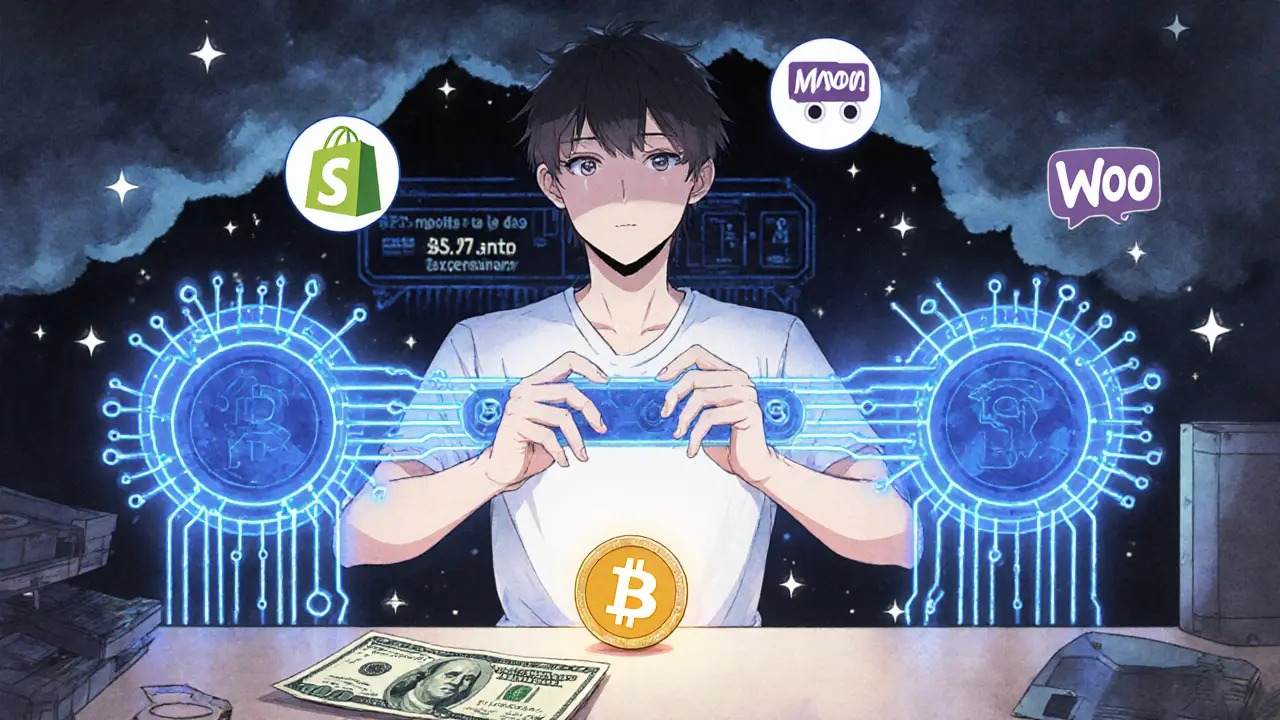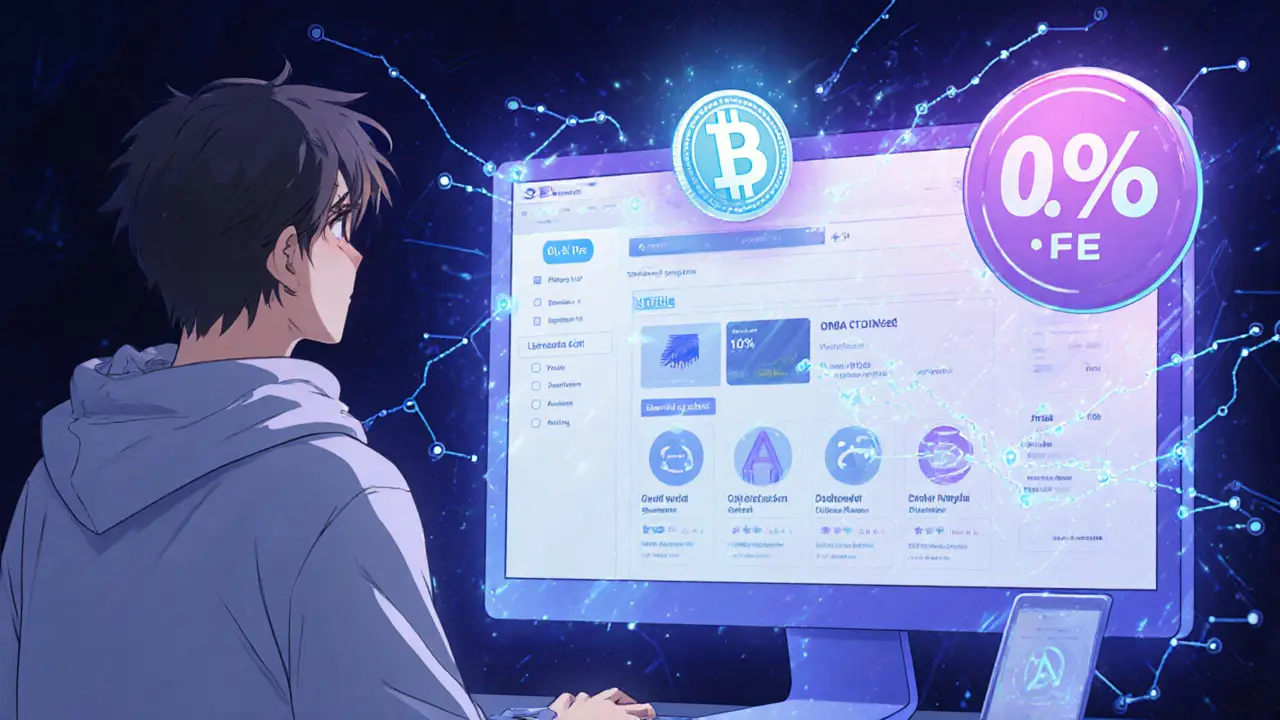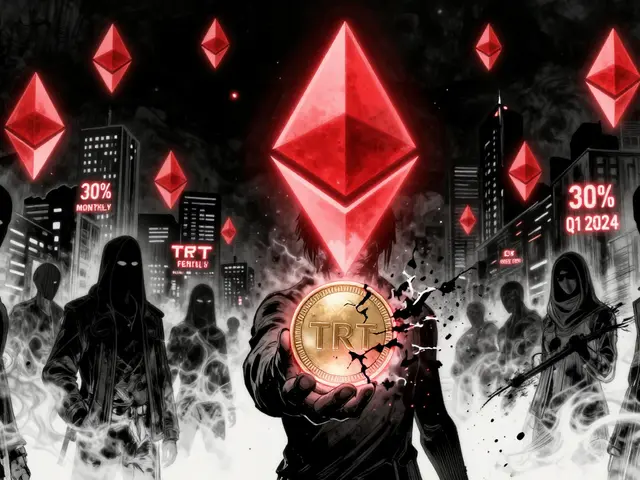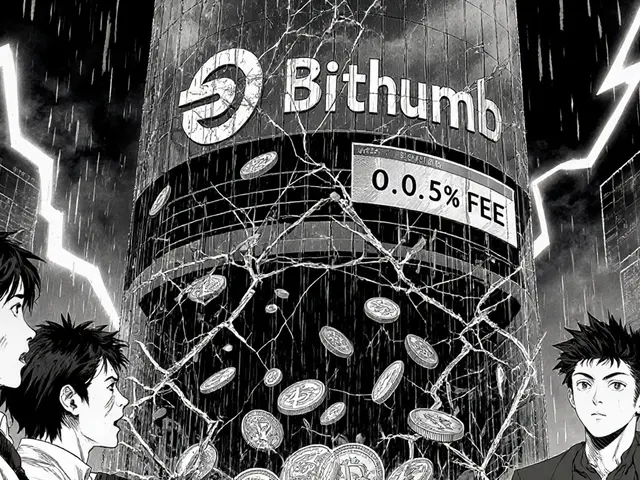SMT Payment Fee Calculator
Compare the cost of using SMT payment processing versus traditional payment processors. SMT offers fees as low as 0.5% compared to standard 2.9% + $0.30 fees from services like Stripe or PayPal.
Results
SmartMall (SMT) isn’t another meme coin. It’s a utility token built for one specific job: helping real businesses move from regular websites to blockchain-powered systems. Launched in early 2025, SMT powers the SmartMall.ai platform - a tool that lets online stores, payment processors, and service providers connect their existing Web2 apps (like Shopify or WooCommerce) with decentralized finance tools. But here’s the catch: while the idea sounds useful, the token itself is in rough shape.
What Exactly Does SMT Do?
SMT is the fuel inside the SmartMall.ai ecosystem. If you run a small online store and want to accept crypto payments without dealing with complex wallets or high fees, SmartMall.ai offers a plug-in. You connect your store, users pay in SMT, and the platform converts it to fiat or other tokens behind the scenes. The token is used to pay for these integrations, cover transaction fees (as low as 0.5% vs. 2.9% for credit cards), and vote on platform upgrades through a DAO.
Unlike Bitcoin or Ethereum, SMT doesn’t exist on its own blockchain. It’s a BEP-20 token running on BNB Smart Chain - the same network that powers Binance Coin. That means you can store it in MetaMask by adding the contract address: 0x658cda444ac43b0a7da13d638700931319b64014. You can also add it directly through CoinGecko’s wallet tool. No fancy hardware needed.
Current Price and Market Stats (as of November 5, 2025)
As of today, one SMT is worth about $0.0115. That’s down 98.2% from its all-time high of $0.6432 in April 2024. The total supply is capped at 100 million tokens, and 92 million are already in circulation - meaning almost all of them are out in the market. That’s unusual. Most projects hold back a big chunk for team or development use. Here, 92% is already circulating, which raises red flags.
The market cap is around $1.06 million, making SMT the #2,847 largest cryptocurrency by market value. Its 24-hour trading volume? Just $5,000. That’s extremely low. For comparison, even tiny coins with similar market caps usually trade at least $50,000 daily. Low volume means big price swings. If someone tries to sell $1,000 worth of SMT, the price could drop 15-20% before the trade finishes. That’s not normal trading - it’s manipulation waiting to happen.
Where Can You Buy SMT?
You won’t find SMT on Binance, Coinbase, or Kraken. It’s only listed on three small exchanges: LBank, CoinEx, and Bitrue. That’s it. If you’re not already using one of these platforms, you’ll need to sign up, verify your identity, and transfer funds over. Most users report slow customer support and no mobile app. There’s no easy way to buy SMT with a credit card. You’ll need to first buy USDT or BNB, then swap it for SMT.
Even if you manage to buy it, selling is harder. With so little volume, finding a buyer at a fair price is a gamble. Many traders who bought at $0.10 or higher are still stuck with losses.

Who’s Using It? Real Examples
SmartMall.ai claims 17 active business partnerships - mostly small e-commerce stores and fintech apps in Southeast Asia and Eastern Europe. One user on CoinStats reported using SMT to pay a Shopify vendor in Poland, and the transaction cleared in under 10 seconds with a 0.5% fee. That’s faster and cheaper than PayPal or Stripe.
But here’s the problem: most of these integrations are still in testing. Trustpilot reviews for SmartMall.ai average just 2.3 out of 5. One user wrote: “Promised business integrations never materialized despite a 6-month wait.” Another said their store’s SMT payment option disappeared after two weeks. The platform’s roadmap promises a “Version 2.0” launch in December 2025 with cross-chain support - but that’s been delayed before.
The Big Risks
There are three major risks with SMT:
- Extreme Concentration: 92% of tokens are already circulating. That means the team, early investors, or insiders control nearly all of it. If they dump even 5% on the market, the price could crash again.
- Low Liquidity: With $5,000 in daily trading volume, there’s no safety net. You can’t easily get in or out without losing money.
- Regulatory Risk: The U.S. SEC released new guidance in October 2025 saying utility tokens with over 90% circulating supply may be classified as unregistered securities. SMT fits that description. If regulators step in, exchanges could delist it overnight.
Dr. Elena Rodriguez from Delphi Digital called SMT “a bridge too far” in her October 2025 report. She pointed out the token’s 98% drop from its peak wasn’t just market noise - it was a sign of broken trust.

Why Some People Still Believe in It
Not everyone thinks SMT is dead. Jason Kim from Blockchain Ventures argues that SMT’s focus on real business use - not gambling or yield farming - could be its strength. He notes that 17 enterprise partnerships, even if small, show there’s demand for the service. Galaxy Digital’s November 2025 report suggests that if half of those 17 businesses sign paid contracts by early 2026, SMT could rebound 300-500%.
There’s also the fact that SmartMall.ai’s platform actually works. If you’re a developer or small business owner who needs to accept crypto without the hassle, the backend tools are solid. The problem isn’t the tech - it’s the token economics.
Should You Buy SMT?
Here’s the honest answer: if you’re looking for a safe investment, skip it. The risks far outweigh the potential rewards. The price has collapsed. The volume is tiny. The team has no track record of delivering on promises. This isn’t a coin you buy and hold for years.
But if you’re a tech-savvy user who wants to test the platform - maybe you run a small online store and want to experiment with crypto payments - then you could buy a small amount ($20-$50) just to try it. Treat it like a test, not an investment.
Don’t invest money you can’t afford to lose. Don’t chase “cheap” tokens just because they’re below $0.01. That’s how people get burned.
What’s Next for SmartMall?
The team says Version 2.0 is coming in December 2025. If they actually deliver cross-chain support (meaning SMT can move beyond BNB Smart Chain), it could open doors to bigger exchanges and more users. But they’ve missed deadlines before. Watch for:
- Real increase in trading volume (over $100,000 daily)
- Listing on at least one major exchange (like KuCoin or Gate.io)
- Public audit reports from third-party security firms
- Actual revenue from business contracts, not just announcements
If none of that happens by March 2026, SMT will likely fade into obscurity - another forgotten project in the long list of failed crypto experiments.







Steven Lam
November 7, 2025 AT 01:04SMT is just another rug pull dressed up like a business tool
Sierra Rustami
November 8, 2025 AT 10:42If you're buying this you're already losing. Period.
Pranjali Dattatraya Upadhye
November 8, 2025 AT 21:54I know a small shop owner in Bangalore who tried SMT for a month-said the integration worked fine but the customer support ghosted them after the first week. The tech isn’t broken, it’s just abandoned.
Glen Meyer
November 10, 2025 AT 04:40Why are we even talking about this? It's a dead coin with a fancy website. The team probably cashed out months ago and is now sipping margaritas in Bali while we argue about contract addresses.
Ryan McCarthy
November 10, 2025 AT 17:03I get that people want to believe in something real in crypto, but this feels like holding onto a balloon that’s already lost its helium. The platform might be useful-but the token? It’s just a ghost in the machine.
Abelard Rocker
November 11, 2025 AT 13:19Let me paint you a picture: imagine a guy who builds a fancy doorbell that actually works-but then he sells you the doorbell’s soul as a collectible trading card, and now you’re holding 92 million of those cards, and nobody wants to buy them because the doorbell’s been unplugged for six months. That’s SMT. It’s not a coin, it’s a funeral pyre with a whitepaper.
Hope Aubrey
November 12, 2025 AT 21:29Low volume + 92% circulating supply = regulatory grenade. SEC’s gonna come in like a SWAT team with a subpoena and a PowerPoint titled ‘Why This Isn’t a Utility Token’.
andrew seeby
November 13, 2025 AT 21:21imagine if u could pay for your coffee with smt and it just worked 😍 but then u check the price next week and its 1/10th… still kinda cool tho? 🤷♂️
Kyung-Ran Koh
November 15, 2025 AT 16:27It’s important to separate the platform from the token. The backend tools for integrating crypto payments are genuinely useful for small businesses. The problem isn’t the tech-it’s the tokenomics, which are dangerously misaligned with real-world adoption.
Missy Simpson
November 17, 2025 AT 14:15if you're thinking of buying smt just for fun, go for it-but only with pocket change 💸 i'd treat it like a science experiment, not a portfolio move 🧪✨
Michelle Stockman
November 18, 2025 AT 16:12Someone actually wrote a 2000-word essay on a dead coin. Congratulations. You’ve just won the 2025 Crypto Delusion Award.
Arjun Ullas
November 19, 2025 AT 10:16Let us be unequivocally clear: this token exhibits all the hallmarks of a premeditated exit scam. A 98.2% price collapse, a 92% circulating supply with no vesting schedule, zero liquidity, and listings only on obscure exchanges-these are not coincidences. They are signatures. The team has already harvested the liquidity, and what remains is a hollow shell masquerading as innovation. The fact that anyone still defends this as a ‘utility token’ reveals a profound misunderstanding of both blockchain economics and fiduciary responsibility. This is not a project-it is a forensic case study in how not to launch a cryptocurrency.
Tara R
November 21, 2025 AT 09:24People still talk about this like it has a future. It doesn't. The only thing growing here is the graveyard.
Matthew Gonzalez
November 22, 2025 AT 00:27It’s funny how we treat crypto like it’s either a religion or a casino. SMT isn’t evil-it’s just a failed experiment. The real question isn’t whether it’ll rebound, but why we keep building these fragile towers of trust on sand.
Eric von Stackelberg
November 22, 2025 AT 08:1292% circulating supply? Low volume? SEC guidance? This isn’t coincidence. This is coordinated. The entire thing was designed to lure retail investors into a liquidity trap while insiders quietly moved their holdings to stablecoins months ago. The ‘business partnerships’? Likely shell companies controlled by the dev team. The ‘roadmap’? A mirage. This is state-sponsored crypto fraud, and the regulators are asleep at the wheel.
Alexis Rivera
November 22, 2025 AT 20:36There’s value in trying new things-even flawed ones. If you’re a small merchant and you want to test crypto payments without paying 3% to Stripe, SMT’s tooling works. Don’t invest in the token. But if you’re curious about the tech, spend $20. Learn. Then move on. That’s not gambling. That’s education.
Christopher Evans
November 23, 2025 AT 04:59Thank you for this detailed analysis. The distinction between platform utility and token speculation is critical, and too often overlooked. The data presented here is clear, and the risks are well-documented. Investors should proceed with extreme caution-or better yet, avoid entirely.